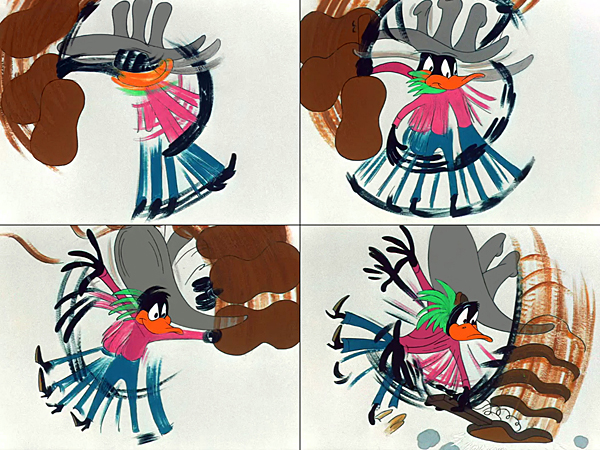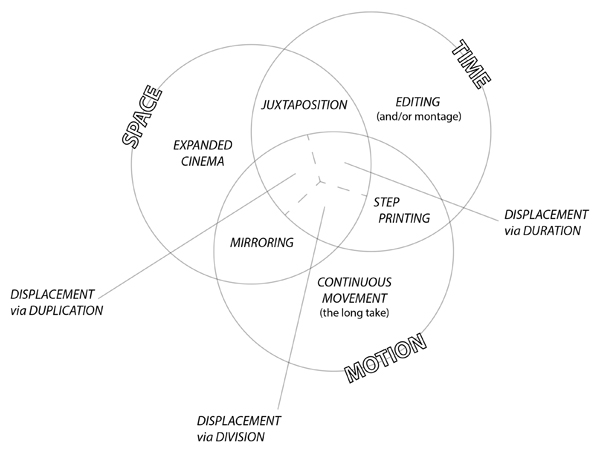|
This theory work will be published as a book-length monograph Beyond Spatial Montage: Windowing, or, the Cinematic Displacement of Time, Motion, and Space by Focal Press.
Part 1 of a 6 Part series proposing an expanded theorization of spatial montage, excerpted from a current book project.
Foundations Links Between Time, Motion, and Space
The typical cinematic image (either in long take or montage form) appears in the absence of additional constraints: the �pure� form of Motion is the long take (undisplaced movement contained by the long take); montage/editing are each a �pure� form of Temporal displacement, apparent through the ruptures created by the cut; the �pure� form of Spatial displacement lies with the use of multiple projection�a use that forms a range lying between apparently discrete screens and the composite screen produced by aligning the edges of one projector with another as in cinemascope or Able Gance�s Napoleon. Distinguishing between time, motion, and space in a theoretically precise manner allows for a more robust theorization of windowing: the distinction between one dimension and another is instantly apparent in the affect resulting from watching the motion picture itself. Each of these dimensions can be readily distinguished from the others through our encounter with it on screen: the affect it has determines its location within this taxonomy.
3.5.1 TIME
Time Displacement is the repetition and fragmentation of the duration of what appears on screen, either within discrete parts of the frame, or by replacing the entire image shown on screen.
Works organized around the manipulation and modulation of Time are the easiest to recognize since the �time� of what appears is constructed through discrete shots pieced together. Motion picture employing editing (and montage) to construct the work from discrete, singular units juxtaposed in a temporal sequence, one after the other. All the varieties and variations of editing�Soviet montage, Hollywood�s system of continuity, graphic matches, etc.�function as a basically identical method: the assemblage of discrete, short durations in a linear sequence that decompose motions and displayed actions into smaller units. The various theories of montage, such as those of Eisenstein, Pudovkin, et. al. are all systems focused on the organization and combination of these short shots over time.
The interruption of continuous motion that the edit inherently is results in a dramatic shift in space and perspective on screen: each image appears as an entire replacement of what was on screen previously. The relationship between individual shots emerges within the minds of the audience; every shot is singular, the degree of its disruption simply being an exaggeration of the underlying sequential nature of images in a motion picture�where normally only small differences appear, resulting in motion, with sufficiently large differences, the change becomes a change of shot. Situations where the differences are less dramatic, or in which only a few elements change result in scenes that are transformative in nature, seemingly unedited.
3.5.2 MOTION
Motion Displacement is the repetition and fragmentation of continuous movement whether occupying the full frame or contained by smaller �windows.�
In its basic form, the element of �motion� appears as continuity of action and movement on screen. The long take, with its emphasis on this continuous sequence of motion on screen (and in consequence much longer durations than employed in continuity and montage editing) structures the motion picture very differently than editing does.

What disruptions that do appear are a function of the sampled nature of animated imagery generally. The short series of frames where Daffy Duck shatters a guitar in Chuck Jones� Duck Amuck (1953) �might appear to be a �cubist� repetition of movement when seen as a sequence of stills, however, they are not cubist. The duplications of Daffy in these frames are accompanied by streaks that suggest exceptional speed; this short sequence is emphatic in its destruction of the guitar, the speed is a performative consequence of this dramatic function�it occupies barely � second of screen time before returning to normalcy. While the technical means�replicated imagery within the frame�might resemble the displacement of Cubo-Futurist painting, or even the step-printing effects that appear in Norman McLaren�s film Pas De Deux (1968), the brevity of the sequence, coupled with its use of streaks signifying high speed motion as well as the affect it has within Duck Amuck argue against such an understanding. The sequence does not seem to be displaced at all during the film�instead it merely appears as a moment of highly dramatic motion. A fifth frame presents an almost complete return to normalcy after Daffy has shattered the instrument�only a single �echo� of his motion appears, and the dramatic gesture is essentially over. Any similarities to Cubo-Futurist fragmentation of motion are a reflection of the influence that Jules-Etienne Marey�s chronophotographs had on Marcel Duchamp�s work in particular, such as the Nude Descending a Staircase (1912). These repetitions within a single frame act as a representation of high-speed, continuous motion that movies faster than 24 frames per second, the standard for sound film. The repetitions that would under other circumstances qualify as �echoes� in this case appear instead as greatly accelerated movement; the rest of the sequence before and after this group of four frames proceeds normally. However, these few frames do demonstrate the continuity between standard, continuous motion and the shift into displacement: it is a matter of degree and affect, not necessarily an inherent difference in technical means.
Where editing acts as a structuring of multiple, discrete and independent images over a specific duration, in the long take, these distinct images become instead the continuous motion of the mise-en-scene as shown by a series of fluid camera positions all contained within one shot composed to avoid or minimize editing entirely. Orson Welles� Touch of Evil (1958) opens with an extended long take whose action runs in �real time��the duration set on the timer that appears at the beginning of the shot ends at the first edit in the film�the resulting explosion. The action of the sequence is focused on the impending explosion, even as the action shown proceeds through an elaborate mise-en-scene produced by a tracking crane shot that introduces Vargas and his wife, as well as gives a portrait of what the boarder town where the film takes place is like. It is the specifically continuous nature of this action that heightens the drama of the sequence�as it is happening in real time�the duration set on the bomb and the duration of the actions shown are identical�as the timer runs out, the sense of watching events play out that audience has increases until the edit that literally interrupts Vargas and his wife on their honeymoon. This dramatic use not only of the continuity of motion within the long take, but the disruptive impact of editing is precisely the focus of the sequence as a whole.
3.5.3 SPACE
Spatial Displacement is the visual repetition and fragmentation taking the visual form of discrete �windows� on screen either within a single frame or through multiple projection.
What matters is the affect the work has, as either a singular screen or multiple screens. Most common in expanded cinema and the multiple screen film/video installation, Space modulates between appearing as a single screen and being self-evidently composed from multiple screens. The distribution of the screen/image across and into physical space defines this dimension explicitly. Most commonly a result of multiple projection, it can assume the shape of a single screen where the different projectors are aligned to enable the illusion of a single image (as with Able Gance�s Napoleon), or may be explicitly composed from individual screens arranged together (as with Stan VanDerBeek�s CultureIntercom and video installations generally).
�Expanded cinema� is the most common label used for the deployment of multiple independent cinematic screens within a single environment. Depending of their arrangement�relative position and proximity�these screens may produce exactly the juxtaposition effects identified with �spatial montage,� but without being composed on the same screen. These effects depend on the same spatial character as discrete frames of imagery sharing the same screen, and should be recognized as being within the same morphological and structural range.
The shift from a represented space within the imaginary volume shown on screen to the physical space in front of and around the screen�is the shift into a cinematic form focused on actual spatial relationships, not only between images shown but between physical surfaces inside the �movie theater� where the screening happens. This is a shift that spatially expands from the flat screen into the potential for multiple screens in actual physical space. It is simply an issue of degree of difference between one screen-surface and another. The displacements and juxtapositions that arise are a function of this physical separation, but at the same time they are simply an intensification of juxtapositions happening on screen with windowing and �spatial montage.�
The shift into physical space from the graphic space contained by the screen is a logical extension of the morphology and structures of juxtaposition and repetition. It is a relationship that enables the recognition of the spatial dimension that organizes both types of displacement, making the differential between combinations of Time�Space and Motion�Space (i.e. the �space� element in itself) formally and conceptually legible as a distinct formal component in the construction of meaning in these hybrid cases.

3.4 COMBINATIONS
Although compound and complex variants of these types of displacement are possible, this analysis will exclusively focus on and discuss them in their �simplest� variety in order to make their formal characteristics readily apparent. The distribution of multiple screens containing different, discrete images throughout an actual physical space (i.e. an environmental installation employing a variety of screens) while not directly addressed by this taxonomy is potentially contained by it in spite of their readily apparent differences: multiple screens or a single screen, the organization of imagery within that screen (and in relation to other screens) will still function in analogous ways.
The hybrid cinematic forms that emerge when combinations of Time, Motion and Space act to determine the morphology and structure of form are agnostic: they do not necessarily dictate any particular protocols for interpretation, nor do they impose precise, limited meanings on these formal organizations of motion picture material. It is this openness to interpretation that enables the vast range of applications that are possible for the materials described by this taxonomy. This foundational trio of general tendencies that when combined follow a different internal logic than when acting as independent, singular concerns. These hybrids that lie in the combination of basic elements are where the development of �spatial montage� and all its related forms are to be found. The expanded field of such relationships, as well as their relationship to well theorized and understood cinematic techniques (long take, montage) as well as their role in the interpretation of cinema (governed by the priorities of realism) is not a morphology whose foundations are the logical extension and expansion of existing morphologies that have historically given rise to these forms because they offer alternative means to achieve identical ends, posed in the realist demand that organizes cinematic form generally.
Beyond Spatial Montage:
Part 1 Foundations
Part 2 Time�Space Displacement
Part 3 Time�Motion Displacement (Step Printing)
Part 4 Motion�Space Displacement (Mirroring)
Part 5 Time�Motion�Space Displacement
Part 6 Afterword
|